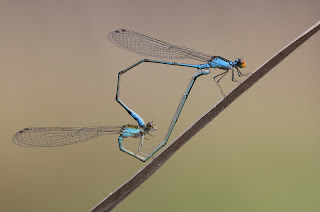No: 23 / Family: Coenagrionidae / Genus: Pseudagrion
Name: Pseudagrion rubriceps rubriceps / Orange-faced Sprite / แมลงปอเข็มบ่อหน้าส้ม
Habitat: Exposed ponds, lakes, drains, slow streams (uplands & lowlands)
Province(s): Widespread
In flight: Year-round / Sightings (by me): Common
Province(s): Widespread
In flight: Year-round / Sightings (by me): Common
Easily confused with: N/A
The first Pseudagrion species I ever saw and managed to get photos of, was Pseudagrion rubriceps rubriceps. It is a very common species and in certain parts of Khon Kaen, there are many, many of them in localised areas. The males are very commonly seen, but the females tend to hide away in nearby bushes, grasses or trees. Unfortunately, they are really difficult to get near and photograph. It has taken me a few years to get photos like the ones below.
The male
It's easy to see why the male is instantly recognisable... it's got a bright, orange head that makes it look a bit like Paul Scholes! The thorax is azure blue and green dorsally and the abdomen is blue with black markings and bright blue end segments.
The (almost) adult male
This male I saw at Nam Nao recently and it is the first I have seen that is in-between the young brownish specimen and the full adult.
The sub-adult male
The young male has all the hallmarks of the adult, but the colours have not yet developed.
The female
The female is often seen in bushes, grasses and trees up to 200 metres from the water's edge. Only when it is ready to mate does it reach the water. The colours of the female are similar to that of the young male. The end segment marking can also sometimes look like a "pacman".
A 'very old' female I saw recently in Khon Kaen...
The fully mature female ...
in action (fending off a male Aciagrion tillyardi ... the purple splodge in the background)
Caught in the act...
I managed to catch this female with my fingers and it gives an idea of size. She returned to her tree afterwards, unharmed. And, yes, I need to cut my fingernails!

The copula
I managed to take a photo of a copula in the "tandem" position.
The copula stayed inter-locked for long periods of time. Note the damage to the female's eye - probably caused by an over-eager male.
The copula stayed inter-locked for long periods of time. Note the damage to the female's eye - probably caused by an over-eager male.


























No comments:
Post a Comment